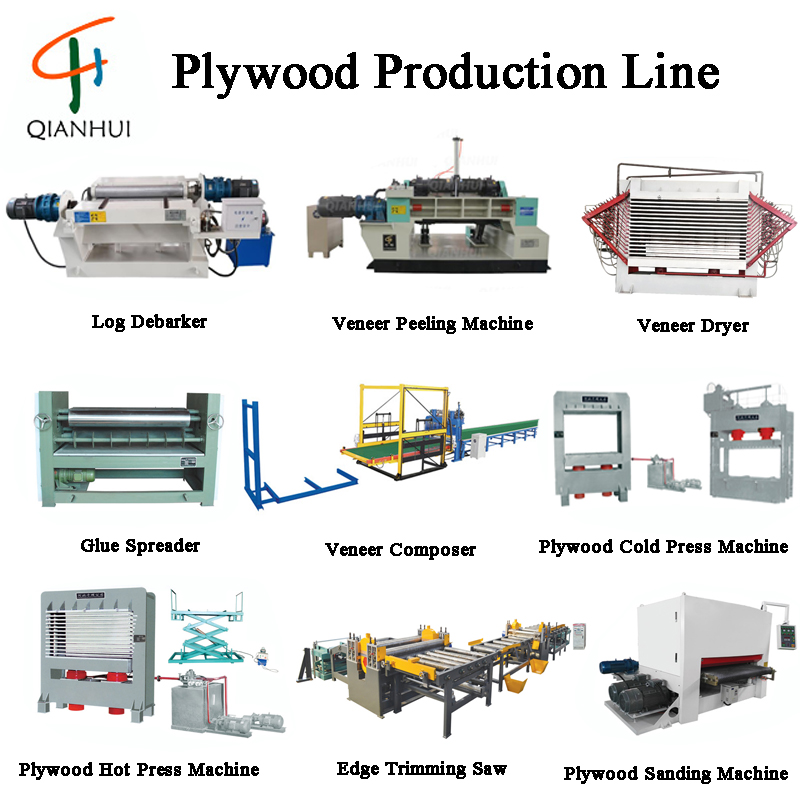Plywood is a wood-based artificial board made of veneers with different grain directions. The veneer textures of adjacent layers usually form a 90°angle with each other. The structure is mostly odd-numbered. In special cases, there are even-numbered layers such as 4 and 6. Due to the characteristics of small deformation, large format, convenient construction, not easy warping, and high tensile strength of horizontal stripes, plywood has been widely used in furniture, carriages, shipbuilding, military, packaging and other industrial sectors. Today Plywood Machine Factory introduces the production process of plywood.

The outermost veneer that composes the plywood is called the face plate, the front face plate is called the face plate, the back face plate is called the back plate, and the inner single plate is called the core plate or middle plate. Veneer is a thin plate made by rotary cutting, planing and sawing. The production process of plywood includes: log truncation, log hydrothermal treatment, peeling, centering of fixed wood sections, veneer cutting, veneer drying, veneer cutting and splicing, veneer shaping processing, veneer gluing, blank assembly, pre-press And hot pressing, trimming, shaving or polishing, inspection, classification and packaging. The main processes are described below.
1. log hydrothermal treatment
It is a process of softening wood and enhancing plasticity. Wood used for sawing veneer does not require heat treatment, and wood or blocks used for planing and rotary cutting require hydrothermal treatment. Its role is to remove the liquid juice contained in the wood, reduce or prevent the cut veneer from chipping or warping, and improve the quality of the veneer. Speed up veneer drying. There are two treatment methods: steaming and boiling. When the average wood temperature is above 40°C, high-quality veneer can be cut.
2.Veneer cutting
More than 98% of the veneers are made by rotary cutting or planing. Rotary cut veneer accounts for 95% of the total output, so rotary cutting is the basic technology of plywood industry. The sawed veneer is only used for instrument making. The key to the quality of sliced veneer lies in the correct installation and adjustment of the planing knife and pressure scale. The key to the quality of Veneer Rotary Cutting Machinery is also the correct installation and adjustment of the rotary knife and the pressure scale. The variable process parameters are the height of the blade relative to the center line of the card axis, the horizontal and vertical distances between the edge of the blade and the edge of the pressure scale, and Rotary knife and grinding angle, back angle, cutting angle, feed angle.
3.Veneer drying
The glue pressing process requires that the moisture content of the veneer should be 5-8%. In order to improve the drying speed, it is necessary to accelerate the heat transfer of the veneer and overcome the drying resistance. The main measures for accelerating heat transfer are to increase the temperature of the drying medium and speed up the circulating air flow. The veneer dryer has undergone several evolutions and improvements. Two types of veneer dryers that are widely used now are jet continuous dryers and drum dryers.
4. Veneer cutting and splicing
The dried veneer or veneer tape must be cut according to certain specifications. A computer-controlled high-speed shearing machine is now in use, but splicing is not required for the entire board. In the 1970s, a new process was created that used nylon wire or glass fiber to glue on the surface of the veneer, which was continuously glued horizontally, or formed into an S-shaped longitudinal cementation on the veneer seams. It still has not completely replaced the use of tape or tapeless stitching Traditional method. Finland has developed efficient termination equipment for short veneers, which successfully solves the problem of manufacturing large-size veneers from small diameter wood and short wood sections.
5.Veneer refurbishment
Including patchwork, termination, patching, indented end cracks, etc. Europe accounts for 35-40% of the total working hours of plywood production, and the situation in China is similar. There are two methods of veneer gluing: roller gluing and gluing. The glue application method has less loss of material, uniform thickness of the glue layer, and high production efficiency. However, it is only used in North America, and Europe and other places mainly use roller coating.
6. Group billet
The veneer is about to form a slab. It has been manual operation for a long time, and automatic blank forming technology only appeared in the early 1970s. The automatic assembly line is especially suitable for factories with single product specifications. But nowadays, except for the American softwood plywood factory, which has used automatic blank forming technology, most factories in other countries are still manual blank forming.
7. Pre-pressing and hot pressing
The purpose of pre-pressing is to make the slab stick to a whole before entering the hot pressing and facilitate the quick loading into the hot press, so as to shorten the no-load time of Plywood Hot Press and reduce the problems caused by the movement of the watch plate and misalignment during installation. Loss of waste products, and the moisture content of veneer can be adjusted to improve product quality. The pre-pressing process is especially necessary for non-pad systems.
Copyright © Hebei Qianhui Macihnery Co.,Ltd. All Rights Reserved | Sitemap |
Technical Support: 